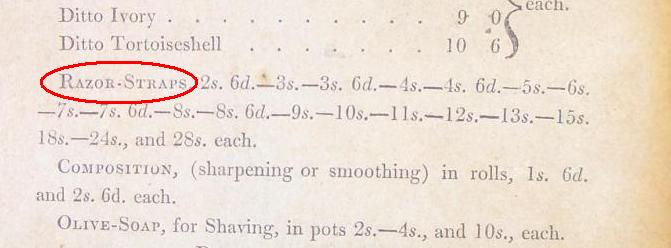Results 21 to 26 of 26
Thread: London, 1830: cost of razors
-
10-06-2009, 04:39 AM #21

sorry I will edit my post to make it clearer. I'm not saying it is comparable to a Dovo best- but if it were it would be expensive. I'm not saying its necessarily comparable to a Livi, but if it were, it would be cheap.
-
10-06-2009, 08:58 AM #22

I can't see how this could be reason for skepticism; this is just data and proportions between different data. Also, in the treatise olive-oil soap is described as something "special", the best solution to prevent irritations coming from other kinds of soap. The soap was prepared with parfumes (etc..), thus being a sort of top-quality product for that time. Also, prices of soap could explain why until middle-XXc. people made soap at home.
This could be true only if you are directly comparing prices of razors in 1830 and prices of razors in 2009. If we have a translation in £ of how affordable razors were in 1830, you can use this price for more refined comparisons with today's life or simply to put old prices in the context of the time, without translating everything in therms of "modern razors".
This is what we know: you needed to work at least 6 days (maybe 12, using different indexed) to buy a razor and - as i mentioned in the first post - this can explain some aspects related to the market of vintage blades in our days. We have proportions between different goods (razors, strops, strop pastes, soaps), and between different kinds of razors (ivory required an extra 20% and tortoiseshell an extra 40% of the razor scaled in horn). Last: since, as said by Khaos, "the relative price changed" and razors are for us a different object compared to 1830, just translate £312 in food [..no, hoglahoo.. this is not the same of cheeseburgers ].
].
Last edited by clavichord; 10-06-2009 at 09:13 AM.
-
10-06-2009, 01:20 PM #23

nevermind I've been an idiot and am pulling one of my posts and editing the other...
The big thing I was getting at but never mentioned is this is for a particular brand of razor. Its not a buying guide, rather, an ad...Last edited by khaos; 10-06-2009 at 01:24 PM.
-
10-06-2009, 01:29 PM #24

I think we need to look at the way the razors were made and the content of the steel. To my understanding, a manufacturer would buy suitable steel (I'm assuming he can't / won't forge his own steel.), have several men swaging the steel into blanks, then it's shaped, polished, marked, hardened, tempered, polished again, then sharpened. That's eight steps for just the blade.
The steel was high carbon content possibly with a high sulfur content. The blanks were cooked with bone, leather and charcoal to impart carbon before a brine quench. While pyrometers were in use, I'd bet that most heat treating was done by eye, explaining why some batches of blades take and hold an edge and some don't.
I contend that 60% +/- of razors produced were of the lower end variety. Make'em in bulk and sell'em in bulk overseas in America. While many have survived, the high end razors were few and far between, even when Victoria ruled the Empire.
But this is about cost. I don't know the source, but I think they left out the low-enders I mentioned. But, those who were just scraping by were shaved once a week for church, probably not by a barber, but by someone who had a razor on the street where they lived.Last edited by GeauxLSU; 10-06-2009 at 01:36 PM.
I strop my razor with my eyes closed.
-
10-06-2009, 01:38 PM #25


Please notice in that 1830 document from London the use of the word "razor-straps" but no mention of "strops" of any kind
Some say strap, some say strop. OED to the rescue! - Straight Razor Place ForumsLast edited by hoglahoo; 10-06-2009 at 01:40 PM. Reason: added graphical clarification
Find me on SRP's official chat in ##srp on Freenode. Link is at top of SRP's homepage
-
10-06-2009, 08:21 PM #26

 Yes, that was me. But it isn't the eBay specimen I photographed; actually, that 1802 copy is still available on eBay (or straight from Joslin Hall). My own pictures can be found through the Bibliography page in the Wiki.
Yes, that was me. But it isn't the eBay specimen I photographed; actually, that 1802 copy is still available on eBay (or straight from Joslin Hall). My own pictures can be found through the Bibliography page in the Wiki.
Just now I found and interesting reference I didn't know to Kingsbury concerning bevel and edge shape.
</offtopic>
Converting historic prices to present day ones is a tricky thing. For one thing, income differences were much larger than they are now. I doubt overall average gives a useful perspective. Median income, or average income per class might be better.


 LinkBack URL
LinkBack URL About LinkBacks
About LinkBacks






 Reply With Quote
Reply With Quote

